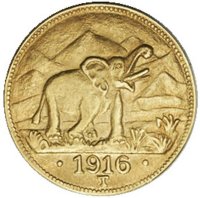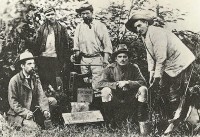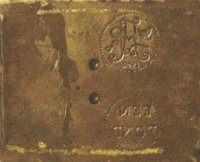

In the middle ages when battles and sieges were part of every day life on the continent of Europe, the soldiers pay had often perforce (by circumstance) to be coined by means of improvised mints and the precious metals of which the coins were composed had to be provided by the cutting up and the melting down of plate, jewellery and miscellaneous baubles.
 Such money was often less precise and of simpler
design than that turned out by the regular mints. Sometimes it would consist
of square, lozenge-shaped or octagonal pieces of clipped metal stamped with
crude designs and letterings.
Such money was often less precise and of simpler
design than that turned out by the regular mints. Sometimes it would consist
of square, lozenge-shaped or octagonal pieces of clipped metal stamped with
crude designs and letterings.
Image right: Kloppers as he was when interviewed by The Star in 1927
Sometimes, on the other hand, the coins would be well executed and attractive in appearance. It all depended on the artistic skill and mechanical ingenuity of the soldier mint-masters. Such coins are termed in numismatic (coin collectors) records as “Siege pieces” or “money of necessity”.
When the civil war raged in England during the seventeenth century the royalist forces were largely paid with such obsidional money. It was of silver and many a splendid punch bowl, flagon, dish and cup went into the making of it.
Ireland, during the stormy period which terminated with the battle of Boyne, 1690, had to pay its fighting men with “gun money”. For this no precious metals were used, but worn out cannon and kettles, pots and pans from the Irish kitchens. A crown piece was made of less than an ounce of Brass or Bronze.
 Money of necessity was struck in
German East Africa during the Great War and
many people in Johannesburg will remember the handsome
elephant sovereigns of gold and the
20 and five heller pieces of copper and
brass that were brought back in considerable numbers by local men
on their return from the East Africa campaign. This money was coined in a
portable field mint at Tabora.
Money of necessity was struck in
German East Africa during the Great War and
many people in Johannesburg will remember the handsome
elephant sovereigns of gold and the
20 and five heller pieces of copper and
brass that were brought back in considerable numbers by local men
on their return from the East Africa campaign. This money was coined in a
portable field mint at Tabora.
South Africa is only represented in this interesting branch of numismatics by one variety of coin-the famous “Veld Pond”. These coins were struck by the Boers at Pilgrims Rest in 1902 during the last few months of the Three Years’ War.
The Veld Pond is a pretty coin, a shade larger than a Sovereign. It is made of practically pure Transvaal gold and its intrinsic value is about 22s. On the one side is a monogram Z.A.R. (Zuid Afrikaansche Republiek) in elegant lettering with the date 1902 beneath. On the other side are the words “Een Pond”. The coin has milled edges.
It was in September, 1901, that General Ben Viljoen set up the rest of his headquarters at Pilgrims’ Rest, the little mining village situated in the beautiful valley about 25 miles north east of Lydenburg. This became the permanent base of the Boer forces under his control. They were the Lydenburg commando of about 400 men under commandant David Schoeman and a corps of 500 Johannesburgers under the general’s brother, Commandant W. Viljoen.
Pilgrims’ Rest had been occupied once by General Buller in 1900, but after that date the sound of war never penetrated the quiet valley. To Pilgrims’ rest were sent from various quarters large quantities of mealies, which were ground in a water mill driven by the Blyde river. Families came there from ravaged districts, marriages were celebrated and the normal life of the community was maintained until the last day of the war. Near the village are the oldest goldfields in South Africa. All the mines were idle, though undamaged, but sufficient gold was obtained to warrant the establishment of a state mint, whence a considerable number of sovereigns was issued.
In January, 1902, General Ben Viljoen was captured near Lydenburg by the British when returning from a visit to the members of the wandering Transvaal government (to evade capture), at that time located at Roos Senejkal, on the Western Slope of the Steenkampsberg. After that the Boer commandos in the north-east of the Transvaal carried on, under General C. Muller, the same policy of semi-passive resistance until the end of the war.
 The man who designed and was responsible for
the issue of the Pilgrim’s Rest sovereigns, the “Veld Ponde”
was Mr. P. J. Kloppers, before the war principal of the Kaapsche Hoop Government
school, in the Barbeton district. Today Mr Kloppers is a school inspector
of the Transvaal Education Department. He was good enough, at my special
request, to accord me an interview the other evening when he told me the
whole story of the “Veld Ponde”, a story that constitutes a numismatic
romance of considerable interest.
The man who designed and was responsible for
the issue of the Pilgrim’s Rest sovereigns, the “Veld Ponde”
was Mr. P. J. Kloppers, before the war principal of the Kaapsche Hoop Government
school, in the Barbeton district. Today Mr Kloppers is a school inspector
of the Transvaal Education Department. He was good enough, at my special
request, to accord me an interview the other evening when he told me the
whole story of the “Veld Ponde”, a story that constitutes a numismatic
romance of considerable interest.
Image right: Kloppers is seated on the left of the photo- note the Veld Ponds on the box in front of "the mint"
The gem of the idea originated in the difficulty which the Boer forces experienced in making purchases of food and other necessities from the natives. The latter were shy of the paper money which was circulating amongst the Boers themselves. They wanted the sovereign – the sovereign which had the horse upon it (the steed of St. George which is found on British Soverigns).
The government’s stock of coined money was practically exhausted. It had, however, a certain amount of bar gold, and it was possible to obtain a further supplies of this precious metal from the smallest mines by scraping the plates and from the alluvial diggings. Mr. Kloppers, who attached to the Rand commando at Pilgrims’ Rest, conceived the notion of making tiny squares of gold, each worth a little more than 20 shillings, which the burgers would be willing to take in exchange for British sovereigns, knowing that they carried a profit with them. He advanced the suggestion to the Transvaal Government, with which the forces at Pilgrims’ Rest were in constant communication, and it was approved.
On further considering the matter, Mr. Kloppers, who has always had a turn for mechanics and chemistry, that something better might be done than merely to imitate the currency of the time of Moses- weighed pieces of precious metal. Why not properly stamped coins? There were mine workshops at Pilgrims’ Rest-silent workshops then without electric power, but containing tools and machinery. Could not a mint be improvised? There were a number of craftsman of various kinds amongst the Boer forces, and Mr. Kloppers discussed the project with some of them.
Eventually, after repeated examinations of the machinery and the tools, it was decided to endeavour to establish a mint and to strike gold sovereigns.
It is interesting to note that Mr. Kloppers did not entertain the idea of manufacturing the sovereigns by hammering-the process by which most coined money had been made from the dawn of minting art up to comparatively modern times-but that he aimed at, and succeeded in his purpose, adapting machinery found in the mine workshops to the manufacture of coins by the screw and press, in collar and with milled edges, having in fact, the main characteristics of the modern sovereign.
 The first essentials were the dies (seen right). After
having made himself tiny chisels of hardened steel Mr. Kloppers took a piece
of suitably softened steel and engraved upon it in reverse and incuse (formed
by hammering, stamping, or pressing) the designs which he proposed to implement
upon the sovereigns. The next thing to harden the dies. This he tried by
heating them and then plunging them into cold water. The dies cracked and
all of the labour was wasted. A second pair of dies was made and these were
plunged into oil. These dies cracked too.
The first essentials were the dies (seen right). After
having made himself tiny chisels of hardened steel Mr. Kloppers took a piece
of suitably softened steel and engraved upon it in reverse and incuse (formed
by hammering, stamping, or pressing) the designs which he proposed to implement
upon the sovereigns. The next thing to harden the dies. This he tried by
heating them and then plunging them into cold water. The dies cracked and
all of the labour was wasted. A second pair of dies was made and these were
plunged into oil. These dies cracked too.
Again and again fresh dies were engraved and unsuccessful attempts made to harden them. Mr. Kloppers patience was wearing thin, but he persevered and the sixth experiment was success. He then had serviceable dies.
A hand punching-machine worked on the screw and press principal like a copying press was found. This machine was adapted to hold the dies, which were brought into close contact by turning the screw. From the other items that were in the workshops a hand roller was contrived by which pieces of bar gold after smelting in a crucible could be rolled between two cylinders into strips of suitable thickness.
It was a breathless moment when the portion of the strip was placed between the dies and the screw was applied. Satisfactory impressions resulted.
The next step was to cut out disks or blanks of the size of the sovereigns from the gold strips. This was easily done by removing the dies from the expunching machine and making further adaptations. A disk was then inserted between the dies, but the pressure caused it to expand laterally, leaving raised round the impressions. Mr. Kloppers donned his thinking cap again and a collar was evolved. A circle exactly sovereign size and depth was cut in hardened steel. The inside of this steel circle was neatly grooved with a file and the circlet was then fitted the lower die.
Another thrilling experiment was made. A blank was placed in the receptacle formed by the collar and the lower die. The upper die was then brought forcibly upon the blank by the means of the screw. This time the lateral expansion caused by the pressure merely forced gold into the grooves of the collar, forming the milled edges of the coin.
The machinery was then complete for string sovereigns, but the difficulties were not yet all surmounted. One was the refining of the gold, especially that used after the small stock of pure gold bar was finished. Some of this other gold contained a considerable amout of dross (impurities).
The greatest difficulty, however, was in bringing the gold to the right consistency for striking. After repeated passages through the rollers it would be too hard. The annealing (heating and cooling) made it too soft. The necessary chemicals were not at the disposal of the amateur coiners and all sorts of substances were tried.
None were to of avail until the sublimate of mercury, an antiseptic from the ambulance stores, was experimented with. This proved a great success and the work of minting the “Veld Ponde” proceeded. It was a slow process, everything having to be done by hand. The blanks had to be carefully weighed and excesses filed off. Coins imperfectly struck went back into the crucibles. Only examples which passed a careful examination were allowed to exist.
The work was carried out with great formality and exactness. A mint commission was appointed, the chairman of which Mr. Andre Pienaar, today the well known chairman of the Public Service Commission. A meticulous record was kept. Each morning an exactly measured quantity of gold was handed over to Mr. Kloppers, whose high sounding title was “Hoofd van de Staatsmunt to Velde” (Chief of the State Mint in the field), and each evening he would hand back exactly the same weight, including the coins that had been struck during the day.
The “Veld Ponde” were easily disposed of. From the first they were curiosities and were eagerly acquired by those burgers that had sovereigns to exchange for them. Their number was limited by the quantity of gold that was at the disposal of the Mint commission, that was not large. The output fluctuated with the supplies, but the striking of the Veld Ponde continued until the last days of the war. The total number struck was between 950 – 1 000, the exact figure, so far as Mr. Kloppers recollection goes is 986.
The members of the Transvaal government were highly pleased with the sovereigns, State Secretary Reitz being particularly enthusiastic. At the conclusion of hostilities Mr. Kloppers and his two assistants Messrs. W. Ried and D. Graham, and the members of the commission were all presented by the Transavaal government, as a memento of the services that they had rendered in the regard of the State Mint in the field, with a gold ornament of great interest.
 They
are made from the same press as the sovereigns, seven in all were struck.
That give to Mr. Kloppers is a trefoil shape about the same size of three
sovereigns arranged in that form. The centre of one side stamped and the
obverse die of the “Veld Pond”, “Z.A.R. 1902”. (presented
by the government of South African Republic). On the other side of the ornament
is engraved in decorative fashion, “P. J. Kloppers, Staatsmunt te Velde,
1902”. Mr Kloppers naturally prizes the ornament very highly and it
will be handed down in his family as heirloom. The ornaments given to the
other recipients were precisely similar except the difference in the names.
They
are made from the same press as the sovereigns, seven in all were struck.
That give to Mr. Kloppers is a trefoil shape about the same size of three
sovereigns arranged in that form. The centre of one side stamped and the
obverse die of the “Veld Pond”, “Z.A.R. 1902”. (presented
by the government of South African Republic). On the other side of the ornament
is engraved in decorative fashion, “P. J. Kloppers, Staatsmunt te Velde,
1902”. Mr Kloppers naturally prizes the ornament very highly and it
will be handed down in his family as heirloom. The ornaments given to the
other recipients were precisely similar except the difference in the names.
Image right: The type of medal presented to Mr Kloppers
“ Veld Ponde” are pretty scarce today. Years ago numbers of them were mounted and worn by their possessors as broaches or watch chain pendants, a fate that also befell the Burgers sovereigns of 1874. Some specimens of both coins also underwent the indignity of being pierced. Fine, well preserved, untouched specimens of both are however, still to be met for the fastidious collector.
During the latter part of the three years War (Anglo-Boer War) there were also current in the Transvaal numbers of blank disks of sovereign size. Some had raised edges and some were quite plain. These discs are of very little interest compared with the Veld Ponde, as they bear no distinguishing stamp whatsoever.
They were sovereigns in the process of manufacture and were put into circulation from the Pretoria mint before the British occupation of that city. They were issued in that form because the dies which would have converted them into ordinary kruger sovereigns were broken. New dies were ordered from Europe but they were intercepted by the British on their way out. Many people had private inscriptions engraved onto the specimens of these gold blanks in their possession.
It may also be added in conclusion that there was also at Pilgrims’ rest a State printing office in the field, which among other activities, produced Transvaal Government notes of the values of £1, £5, and £10. Mr. Kloppers also has some of this money in his possession, which was obviously printed on pages taken out of school exercise books. The only ornamental feature about these Pilgrims’ Rest notes is the Republican coat of arms, which was printed from a die made by Mr. Kloppers.